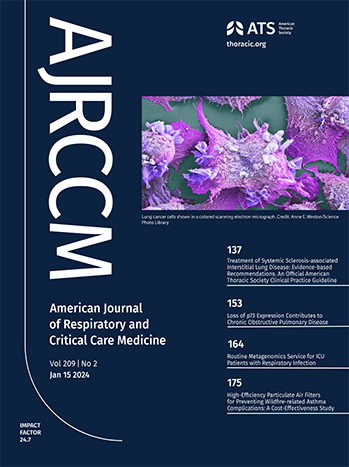Accurate and Early Diagnosis of NSCLC Using Aberrant Fragmentomic Features of Circulating Cell-Free Mitochondrial DNA.
IF 19.4
1区 医学
Q1 CRITICAL CARE MEDICINE
American journal of respiratory and critical care medicine
Pub Date : 2025-09-17
DOI:10.1164/rccm.202411-2247oc
引用次数: 0
Abstract
BACKGROUND Early differential diagnosis of benign and malignant lung diseases is a critical challenge in the clinical oncology of non-small cell lung cancer (NSCLC). We aim to develop a novel strategy utilizing circulating cell free mtDNA (ccf-mtDNA) fragmentomics for accurate and early diagnosis of NSCLC. METHODS We analyzed capture-based ccf-mtDNA sequencing data of 2,306 plasma samples from 1,357 NSCLC patients, 432 benign lung diseases (BLD) patients, and 517 healthy controls (HCs) obtained from three hospitals. Subsequently, using ccf-mtDNA fragmentomic features, we developed models for Differential diagnosis of Benign and Malignant lung diseases (DBM) and Early Diagnosis of NSCLC (EDL). RESULTS Our analysis revealed significantly aberrant fragmentomic features of ccf-mtDNA in NSCLC patients compared with those in BLD patients and HCs. Remarkably, the DBM model demonstrated remarkable capability to distinguish NSCLC from BLD, outperforming serum biomarkers with an AUC exceeding 0.9551 in three validation cohorts. Still, the DBM model exhibited superior diagnostic performance even for small nodules (< 1 cm), achieving an AUC of 0.9151. Moreover, the DBM model demonstrated precise clinical management ability of pulmonary lesions, thereby avoiding unnecessary invasive procedures in BLD patients and preventing delayed treatment in NSCLC patients. Furthermore, the EDL model demonstrated outstanding performance in detecting stage 0 - Ⅰ NSCLC, with an AUC exceeding 0.9759. CONCLUSIONS Our multicenter study provides a novel non-invasive approach using ccf-mtDNA fragmentomics for the differential diagnosis of benign and malignant lung diseases and early diagnosis of NSCLC, with potential applications in clinical decision-making in the management of NSCLC.利用循环无细胞线粒体DNA异常片段组学特征准确、早期诊断非小细胞肺癌。
背景:良性和恶性肺疾病的鉴别诊断是非小细胞肺癌(NSCLC)临床肿瘤学的一个关键挑战。我们的目标是开发一种利用循环细胞游离mtDNA (ccf-mtDNA)片段组学来准确和早期诊断非小细胞肺癌的新策略。方法:我们分析了来自三家医院的1357名非小细胞肺癌患者、432名良性肺疾病(BLD)患者和517名健康对照(hc)的2306份血浆样本的ccf-mtDNA测序数据。随后,利用ccf-mtDNA片段组学特征,我们建立了良性和恶性肺疾病(DBM)鉴别诊断和非小细胞肺癌(EDL)早期诊断模型。结果我们的分析显示,与BLD患者和hcc患者相比,非小细胞肺癌患者的ccf-mtDNA片段组学特征明显异常。值得注意的是,DBM模型在区分NSCLC和BLD方面表现出了显著的能力,在三个验证队列中优于AUC超过0.9551的血清生物标志物。尽管如此,DBM模型即使对小结节(< 1 cm)也表现出优越的诊断性能,AUC为0.9151。此外,DBM模型显示了对肺部病变的精确临床管理能力,从而避免了BLD患者不必要的侵入性手术,防止了NSCLC患者的延迟治疗。EDL模型对0 -Ⅰ期NSCLC的检测效果较好,AUC超过0.9759。结论本多中心研究为ccf-mtDNA片段组学在肺良恶性疾病鉴别和NSCLC早期诊断中提供了一种新的无创方法,在NSCLC治疗的临床决策中具有潜在的应用价值。
本文章由计算机程序翻译,如有差异,请以英文原文为准。
求助全文
约1分钟内获得全文
求助全文
来源期刊
CiteScore
27.30
自引率
4.50%
发文量
1313
审稿时长
3-6 weeks
期刊介绍:
The American Journal of Respiratory and Critical Care Medicine focuses on human biology and disease, as well as animal studies that contribute to the understanding of pathophysiology and treatment of diseases that affect the respiratory system and critically ill patients. Papers that are solely or predominantly based in cell and molecular biology are published in the companion journal, the American Journal of Respiratory Cell and Molecular Biology. The Journal also seeks to publish clinical trials and outstanding review articles on areas of interest in several forms. The State-of-the-Art review is a treatise usually covering a broad field that brings bench research to the bedside. Shorter reviews are published as Critical Care Perspectives or Pulmonary Perspectives. These are generally focused on a more limited area and advance a concerted opinion about care for a specific process. Concise Clinical Reviews provide an evidence-based synthesis of the literature pertaining to topics of fundamental importance to the practice of pulmonary, critical care, and sleep medicine. Images providing advances or unusual contributions to the field are published as Images in Pulmonary, Critical Care, Sleep Medicine and the Sciences.
A recent trend and future direction of the Journal has been to include debates of a topical nature on issues of importance in pulmonary and critical care medicine and to the membership of the American Thoracic Society. Other recent changes have included encompassing works from the field of critical care medicine and the extension of the editorial governing of journal policy to colleagues outside of the United States of America. The focus and direction of the Journal is to establish an international forum for state-of-the-art respiratory and critical care medicine.

 求助内容:
求助内容: 应助结果提醒方式:
应助结果提醒方式:


